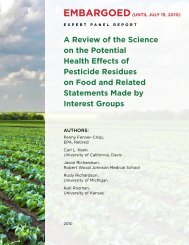—4-"The essentialpiece isto capturepeople's interestm stories and art,the cultural expressionsthat comefrom the heartand the headsof the people."Rita CanttiNational Forest, is glad to have what he desenlies as superiorequipment on the cutting edge of technology. "I don'tgo to work ever without a bullet-proof vest on. We carrysemi-automatic weapons, handcuffs, pepper spray, baton, radio,and pretty much anything else you can stick on aJefibelt."Bryden, the lead law enforcement officer on Alaska'sChugach National Forest, finds one- of his greatest assets to behis canine (K-9) partner. Flash, a Chesapeake Bav Retriever thathas completed rigorous training and wears its own Forest Servicebadge. Like main' employees, Bryden dreamed of working for theForest Service from a young age.'Tretty much, I'm doing what Iplanned on doing my entire life. When Iwas knee high to a gopher,1 planned on working 111 natural resource law enforcement."< ¿•'«TOflanBj SEEKING INSPIRATIONFROM THE FORESTSFor centuries, artistshave been captivatedby the beauty of the mountains, lakes,streams, woods, and wildlife found 111 ourforests and grasslands Clifford Pinchot,the firstChief of the Forest Service,was inspired to the conservation causethrough the 19th-century paintings ofthe Hudson River School that showedscarred mountains 111 the Northeastdevastated by logging and farming.Jim Denney, DistrictFacilities Manageratinthe McKenzie River Ranger StationOregon's Willamette National Forest,is a contemporary artist who shares thesame spirit asthe Hudson River SchoolRita Cantu works for theForest Service as an interpreterand environmental educator,but she is also a storyteller,songwriter, and singer whoplays more than a dozeninstrumentspainters in depicting the changes thathave taken place 111 the landscape. Oneinteresting historical coincidence, according to I )ennev, is that"111 the mid- 19th century, there was a merchant 111 New York whocollected works by the Hudson River painters. Cine painting calledHuma Mountain by Sanford Clifford depicted a clear-cut with a littlecahm in the middle of it. The merchant who bought the paintingwas James Pinchot, and he named Ins son after that painterCliffordPinchot, who became the father of the Forest Service."Traditional artists and crafters have long had aclose relationshipto forests and the materials that they provide. Forest Service archaeologistshave discovered baskets made from spruce roots that are asold asthe earliest civilizations on the North American continent.Weavers today stillmake baskets out of roots, vines, and branches.SMITHSONIAN FOLKLIFE FESTIVAL
4.1>Working for the Forest Service since 1966, Jim Hammer uses pack animals to haul his equipment ashe constructs and preserves trails in Washington's Okanogan and Wenatchee National Forests.Other crafters collect wood, antlers, beeswax,quills, acorns, flowers, twigs, bark, moss, andpine resin to create their arts, crafts, and householdobjects. Woodworkers use forest productsfor a variety of items that run the gamut frompiece is to capture people's interest in stonesand art, the cultural expressions that comefrom the heart and the heads of the people."COOKING AND CAMPINGintricately carved figurines to musical instrumentsand canoes. For instance, Nathan Jackson,a Tlingit woodcarver from Ketchikan, Alaska,has received the prestigious National HeritageFellowship from the National Endowment forthe Arts for his totem poles, clan crests, masks,canoes, and carved doors, all made withinthe traditions of the Tlingit people. When hecarves something, it is intended ro be used, notleft on display. For example, "A canoe is justa boat." he explains, "but it gets you to thinkabout what our people used to do, and howthey put good material to good use. Then thiscanoe becomes an extension of our culture."Forest Service employee Rita Cantú fromSome art isedible, such as pies, jams, andmedicine that have been made from wildfoods and herbs. From the earliest days of tentcamping, cooks have enjoyed making mealson open fires. The love for camp cooking hasnot disappeared, and the National Museumof Forest Service History recently published acookbook with traditional Dutch oven recipesthat have been used in the field by rangers andfire tower lookouts (see Suggested Reading).Jim Hammer, Trails Coordinator on theMethow Ranger District in Washington State,recalls the typical breakfasts (with distinctivenames) that might be eaten by the crew. "If youArizona works with the Conservation andwere with an old packer, like old BillImes, you'dthe Arts program to connect communitiesto nature through the arts. The program usesartists, dancers, writers, musicians, storytellers,have spotted dog [i.e., oatmeal] along with whateverelse you had. And with a couple of the oldpackers, the only variety you'd ever have fromand poets to tellthe story of the growth ofbacon, eggs, and hotcakes was eggs, bacon, andconservation policy in the United States. "It'snot enough just to manage our resourceswherever they might be, separate from thecommunities," Cantu maintains. "The essentialhotcakes. It all the animals were in and breakfastwas ready, we'd have one old boy that'd hollerout, 'The dog's gut a spotl'That meant breakfastwas ready and you'd better be getting up."FOREST SERVICE, CULTURE, AND COMMUNITY
- Page 1: Smithsonianolklife Festival\Food Cu
- Page 4 and 5: The annual Smithsonian Folklite Fes
- Page 7 and 8: —CONTENTSThe Festival's Timely Ap
- Page 9 and 10: —THE FESTIVAL'S TIMELY APPEALLAWR
- Page 11 and 12: COMMERCE FOR CULTUREFrom the Festiv
- Page 13 and 14: [ii]The food concession for the Mel
- Page 15 and 16: oMiiitbioni.indotal SoundL04.A 1 Sl
- Page 17: 1WELCOME TO THE 2005 FOLKLIFE FESTI
- Page 20 and 21: Workers harvest artichokes at Ocean
- Page 22 and 23: —assigned aparticular dish—meat
- Page 24 and 25: I--IPot Pie Farm manager Elizabeth
- Page 26 and 27: ISustainable farmers such as Eliot
- Page 28 and 29: "IThe numberof programsdesignedfor
- Page 30 and 31: .hadSALAD GREENS WITH GOAT CHEESE,
- Page 32 and 33: w.A>wm:~
- Page 34 and 35: —3 3]OCCUPATIONAL CULTUREThe 2005
- Page 36 and 37: employees, the USDA Forest Servicei
- Page 38 and 39: I[3 6]page book, which could fit in
- Page 40 and 41: ká.!i- .>!mKPA backpacker sets up
- Page 42 and 43: --^i'liunterw eight jihI ...itl jib
- Page 46 and 47: I44cutDUTCH OVENONE-POT MEALThomas
- Page 48 and 49: —FUTURE CONCERNS FOR PUBLIC LANDS
- Page 50 and 51: NUESTRA MÚSICA: MUSIC INBuilding C
- Page 52 and 53: plena groups throughout the Northea
- Page 54 and 55: NUESTRA MÚSICA LAUNCHES NEW SERIES
- Page 56 and 57: NUESTRA MÚSICA: MUSIC IN LATINO CU
- Page 58 and 59: "ILos Camperos de Valles son músic
- Page 60 and 61: RAICES LATINASNUESTRA MÚSICA LANZA
- Page 63 and 64: IOMAN: DESERT, OASIS, AND SEARICHAR
- Page 65 and 66: DESERTThe deserts ot the Arabian Pe
- Page 67 and 68: THE FESTIVAL PROGRAMThe 200s Smiths
- Page 70 and 71: 6 8The coiled, leather-covered bask
- Page 72 and 73: 70]COASTAL CRAFTSMANSHIPAND GLOBAL
- Page 74 and 75: [72]Although the oldismaking way fo
- Page 76 and 77: AN OMANI FOLKTALEASYAH AL-BUALYOman
- Page 79 and 80: y%aMUSIC AND DANCE INOMANOMAN CENTR
- Page 81: In the southern Dhufar region, al-b
- Page 84 and 85: ecosystems, identification of plant
- Page 86 and 87: 2:00IIIVorkshopFESTIVAL SCHEDULE (P
- Page 88 and 89: Rhythm,Saturday, June 25 (Programs
- Page 90 and 91: )avidi nestMonday, June 27(Programs
- Page 92 and 93: 1:00IIlamFriday, July 1 (Programs a
- Page 94 and 95:
)utchSunday, July 3(Programs are su
- Page 96 and 97:
EVENING CONCERTSSounds of the Fores
- Page 98 and 99:
theRELATED EVENTS[96]Nuestra Músic
- Page 100 and 101:
IIDónalas Anderson,Washington, D.C
- Page 102 and 103:
'IEd LiíDmi, Studio City, Californ
- Page 104 and 105:
ISudhir Seth, Bethesda, MarylandA g
- Page 106 and 107:
1 if 1 DumberHoneyBeehive Beeproduc
- Page 108 and 109:
1"''NewI >onI Lui\IDon Bustos,Espa
- Page 110 and 111:
Ian Barlow, White Bird,Idaho; Woodl
- Page 112 and 113:
I 'istnet1Gordon Grant,Corvallis, O
- Page 114 and 115:
Kristen Marline, Flagstaff,Arizona;
- Page 116 and 117:
I1 ountries,IIHistorie Site, once t
- Page 118 and 119:
1IworksI1 11Istations are vital to
- Page 120 and 121:
1'IenIpanderetas;JCJ Band. Washingt
- Page 122 and 123:
Ralph Rinzlersongs are "made" (or c
- Page 124 and 125:
I >cmseI VhorahII MiI lameEne Nance
- Page 126 and 127:
|i 2forIIBartlevy1 )oerr;IIParadeSP
- Page 128 and 129:
II AerialIIII1Washington and Jeffer
- Page 130 and 131:
Stack, Bill Stafford, loni Stafford
- Page 132 and 133:
SMITHSONIAN FOLKLIFE FESTIVAL 20051
- Page 135 and 136:
SMITHSONIAN FOLKLIFE FESTIVAL 2005B
- Page 138:
Smithsonian Folklife FestivalSMITHS








